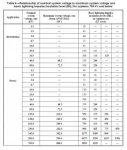Hello! Questions underlined.
-Working on a transformer installation. Primary is 26.4 kV Delta and the secondary is 4.6 kV Wye.
-Client wants a primary 125 kV BIL. I know this is acceptable (what standard defines this?), but typically 150 kV BIL is what's used.
-Because the transformer primary is delta connected...I'm getting mixed information on calculating the lightning arrester rating. At this point I'm at 27kV (22kV MOCV) to accommodate the 26.4 kV system voltage. I'm being told that even though the the primary is delta, the voltage rating of the lightning arrester is line to neutral, not line to line...this doesn't sit right with me. Which is it? Is it ok to have a higher than needed rating for a lighting arrester? Say I only need 18 kV and I specify 27 kV with a larger MOCV?
-Because the I'm at 27 kV for the lighting arrester, my bushing inserts are rated 35 kV. Is there any issue having 35 kV bushings on a transformer with a 125kV BIL?
~Strap
-Working on a transformer installation. Primary is 26.4 kV Delta and the secondary is 4.6 kV Wye.
-Client wants a primary 125 kV BIL. I know this is acceptable (what standard defines this?), but typically 150 kV BIL is what's used.
-Because the transformer primary is delta connected...I'm getting mixed information on calculating the lightning arrester rating. At this point I'm at 27kV (22kV MOCV) to accommodate the 26.4 kV system voltage. I'm being told that even though the the primary is delta, the voltage rating of the lightning arrester is line to neutral, not line to line...this doesn't sit right with me. Which is it? Is it ok to have a higher than needed rating for a lighting arrester? Say I only need 18 kV and I specify 27 kV with a larger MOCV?
-Because the I'm at 27 kV for the lighting arrester, my bushing inserts are rated 35 kV. Is there any issue having 35 kV bushings on a transformer with a 125kV BIL?
~Strap


